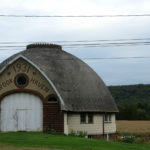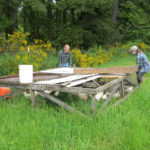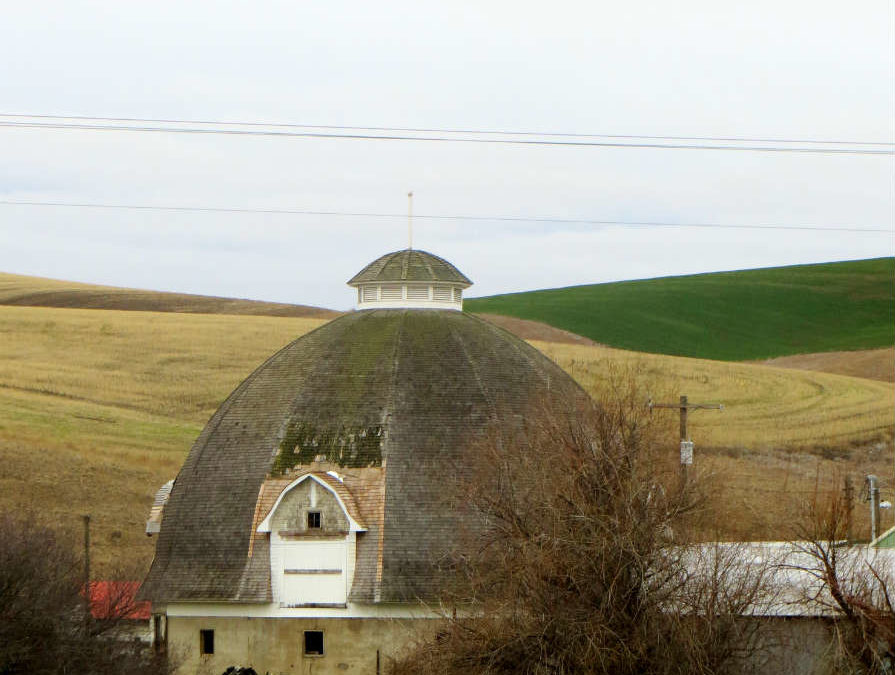Have you ever thought how a farmer decides what to grow? My guess is probably not. So many of us never think where our food comes from, so why would we spend any time asking this question. Wondering where our food comes from is a long standing blind spot in our United States culture. We just expect food to show up. As with any business, a farmer has to make a decision on how to run the business and therefore, on what to grow.

Round Barn in Eastern Washington
So, how do farmers decide what to grow? A successful farmer is a multi-faceted business person. A farmer must know how and where to grow food, how to market the food directly to consumers and institutions or through wholesalers, how to be a bookkeeper (or hire one), to understand land use regulations and water law, how to make sure the food raised is safe from harmful pathogens, and so many more skills and talents that a non-farmer cannot even begin to fathom. Farming can be the ultimate entrepreneurial success story or nightmare, depending on the outcome.
Have you Ever Thought of Being a Farmer?
I grow food. Thirty square feet of garden area in two raised beds on the south and west side of my 5,000 square foot city lot. Rhubarb, green beans, arugula, garlic, a few trellised cucumber plants, a zucchini plant or two, and of course, several types of tomatoes are my main crops. Three hedge-like blueberry bushes, one 8-foot tall Italian prune plum tree, and a pot of basil complete my yard’s agricultural abundance. Not being dependent on my farming acumen is key for my survival. I just get to enjoy whatever I grow. There is no fretting on whether it grows! Tomato and basil bruschetta from my yard is yummy. Bruschetta with red cherry, yellow grape, and green zebra tomatoes mixed together–oh my! Tantalizing my senses with awesome food flavors!
Even with these awesome food flavors, I will never be a farmer–someone who has to make a living from farming. Thankfully, there are men and women who want to farm! So, how does a farmer decide what to grow?
The Commodity Farmer
There are so many different kinds of farmers–farmers that grow commodity crops for corporations, farmers that sell at farmers markets, farmers that sell to packing houses, juicers, or canners, farmers that sell on-site, grain farmers, meat farmers, egg farmers, dairy farmers, grape farmers, wool farmers, and more. There are so many different types of farmers, because there are so many different types of food and food products! There is no one size fits all farmer!

Old Fashioned Round Barn in New York
To keep it simple, perhaps there are two umbrella categories of farmers: the inertia farmer and the entrepreneurial diversified farmer. Inertia farming is the way it’s been done for the past 50 years. Farmers were lulled into inertia farming as the profession was made easier during the 1950’s to 60’s with the Green Revolution by adoption of new technologies in agriculture. Hybridized high-yielding crop varieties, mechanized irrigation, and the creation of fruits and vegetables for long distance refrigerated truck transport rather than taste became the norm. Packaged, processed, predictable food products became the standard. The benefit, guaranteed and commoditized markets for farmers to sell their products to the corporation often through a middleman. It made farming easier as the farmer had guaranteed purchasers and could concentrate on just food growing.
Even so as it became easier, it also became harder because power was taken away from the farmer. Running a farm business became a lot more difficult as corporate behemoths began dictating pricing, pitting one farmer against another to lower commodity prices and consequently farmer livelihoods. This is not the farm story we are taught as children. Urbanites never think about commodity farming as it is not the bucolic farming of childhood story books! It’s important to know that large scale, multi-acreage, single crop commodity farming is the main farm paradigm in this country.
The commodity farmer grows the crop that is always grown. If corn is grown, you are a corn farmer. If soybeans are grown, you are a soybean farmer. There is no variety or change, maybe some rotation between two or three crops, but not anymore diversification.
The Entrepreneurial Diversified Farmer
The entrepreneurial diversified farmer has been the typical farmer since the dawn of the agricultural revolution about 12,000 years ago. This farmer would experiment and expand or change the produce grown or animals husbanded based on rainfall, soil type, seed robustness, taste, pests, plant diseases, and a myriad of other reasons. With 12,000 years of farming experience we now know that if we grow the same product in the same soil all the time, that eventually the soil gets tired because all of the soil’s nutrients have been expended. Further, if you never rotate crops, the bad bugs learn where you grow your carrots and set up house. Commodity farmers address these issues with artificial fertilizers, pesticides and herbicides.
Organic farmers know a different way. According to Nash Huber of Nash’s Organic Product in Sequim, Washington, “I rotate where I grow my carrots every year and they are never in the same dirt for seven years.” If you have never had Nash’s carrots, give them a try. They are off the charts sweet, crispy, and delicious.

Stokesberry Sustainable Farm moving the chicken tractor
For eons, the diversified farmer was the only type of farmer. Now it is the exception. Many diversified farmers grow produce and fruits and combine their farm business with raising animals whether chickens, pigs, cows, or goats. Chickens are easy to add to a produce farm, as the chickens can be housed in chicken tractors, two foot high structures with ample space to move around and peck for seeds or bugs. The structure and chickens are moved as needed to fresh ground. The chickens leave almost, clean bare ground behind has they move along but it is filled with nutrients from their eating and excrement activity. The chicken tractor can be slid between produce rows or placed on fallow ground all while recycling the nutrients of the circle of life of agriculture.
Not being a farmer, but a gardener, my draw to agriculture is strong even though my ancestors were coppersmiths, ship captains, engineers, house painters, bankers, and ministers. There is not one farmer in my known familial history. Even so, the desire to grow food and to eat good, locally- grown, in-season food is visceral from my ancestral heritage. As a child, my Dad helped cultivate my own 5-foot square vegetable garden with green beans, tomatoes and zucchini. June-bearing strawberry picking with my Grandpa and then jam making with my Grandma are memorable. June-bearing strawberries are so much sweeter than the more common ever-bearing berries. Picking lush high bush blueberries in the soggy mosquito infested wetlands was a yearly excursion with my Opa and Oma.
Purchasing food whether at a restaurant, store or farmers market, I do ponder where the food comes from. Eating ethically produced, pesticide free, and organically grown is the best for my health and the planet.
Kathryn Gardow, P.E., is a local food advocate, land use expert and owner of Gardow Consulting, LLC, an organization dedicated to providing multidisciplinary solutions to building sustainable communities. Kathryn has expertise in project management, planning, farmland conservation, and civil engineering, with an emphasis on creating communities that include food production. Kathryn’s blog muses on ways to create a more sustainable world and good food!


Great article. Accurate. Thanks
Thanks so much Joel! Coming from a farmer… I truly appreciate it! Kathryn